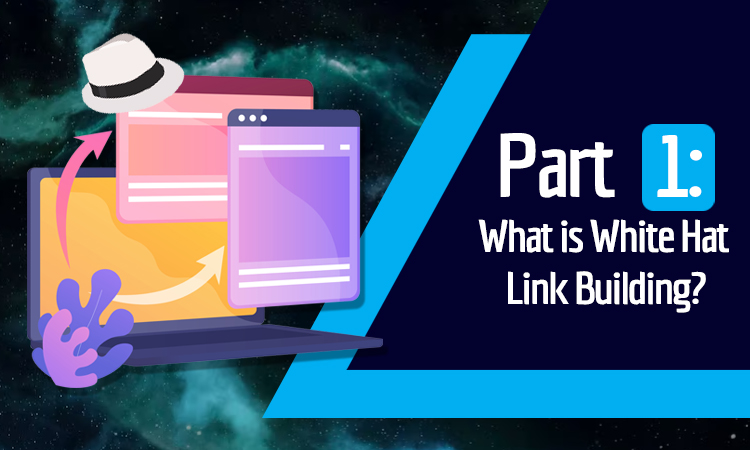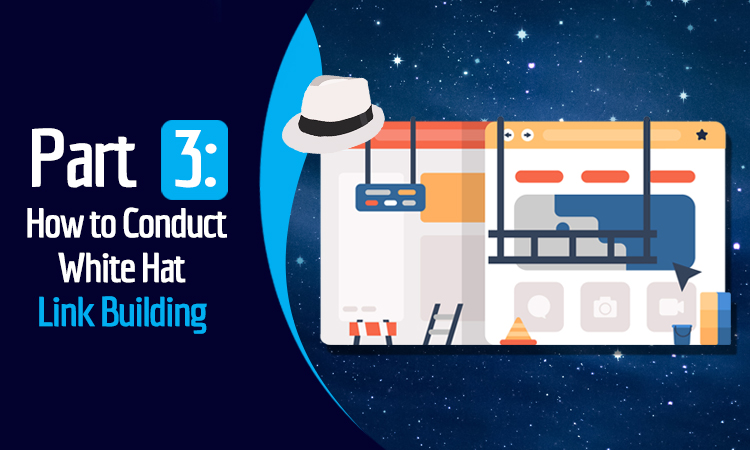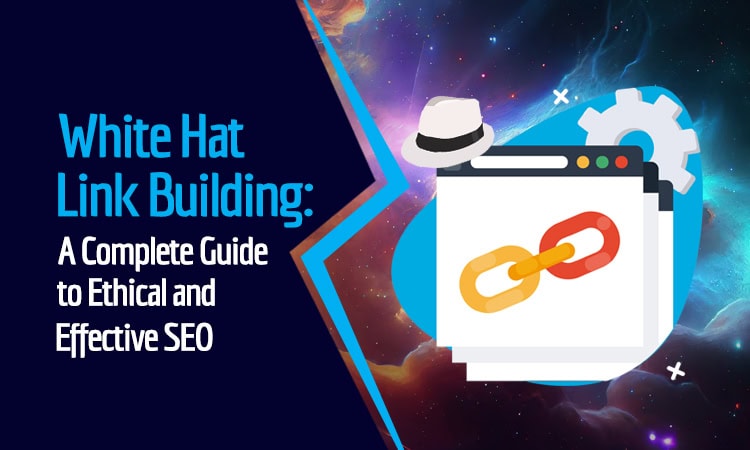White Hat Link Building
As a website owner or digital marketer, you’re likely familiar with the term “link building.” In short, link building refers to the process of acquiring links from other websites to your own.
Why is this important? Search engines like Google use links as a key factor in determining the authority and relevance of a website. The more high-quality links a site has, the higher it’s likely to rank in search results.
However, not all links are created equal. Some link building tactics are considered unethical, and can even lead to penalties from search engines. That’s where white hat link building comes in.
In this post, we’ll explain what white hat link building is, why it’s important, and how to do it effectively.

Part 1: What is White Hat Link Building?
First, let’s define what we mean by “white hat” link building. Simply put, this refers to the use of ethical, sustainable tactics to acquire links from other websites. This includes tactics that are in line with search engine guidelines, such as Google’s Webmaster Guidelines.
What Is Black Hat Link Building?
In contrast, “black hat” link building refers to tactics that are considered manipulative or deceptive, and are often used to try to game the search engine rankings. Examples of black hat tactics include participating in link schemes or creating low-quality content solely to acquire links.
Search Engines Reward White Hat Links
White hat link building, on the other hand, is focused on creating high-quality content and building relationships with other websites in your niche. By doing so, you can attract natural, relevant links that will help improve your website’s authority and search engine rankings.

Part 2: Why White Hat Link Building is Important
Now that we’ve defined what it is, let’s talk about why it’s so important. Here are three key reasons:
-
It’s ethical and sustainable
This type of promotion is ethical because it relies on creating quality content and building relationships with other websites, rather than trying to manipulate search engine rankings. This makes it a sustainable long-term strategy that won’t put your website at risk of penalties or algorithm updates.
-
It improves website authority and search engine rankings
By acquiring high-quality links from other websites, you can improve your own website’s authority and relevance in the eyes of search engines. This can lead to higher search engine rankings, which in turn can drive more traffic to your website.
-
It drives targeted traffic to your website.
When you acquire links from other websites, you’re not just improving your search engine rankings – you’re also exposing your content to a new audience. If the links come from relevant, high-traffic websites, this can lead to targeted traffic to your site.

Part 3: How to Conduct White Hat Link Building
Now that we’ve established why white hat techniques are important, let’s talk about how to do it effectively. Here are three tactics to consider:
-
Guest Posting
Guest posting involves writing a blog post for another website in your niche, in exchange for a link back to your website. This can be a great way to acquire high-quality links while also building relationships with other websites.
To effectively use guest post outreach for link building, you’ll need to follow these steps:
- Identify relevant and authoritative blogs in your niche. Look for websites that have a similar audience to your own and that publish high-quality content.
- Craft quality guest posts. Make sure your guest posts are well-written, informative, and relevant to the audience of the blog you’re writing for.
- Leverage guest blogging for link building, but don’t overlook the opportunity for brand exposure and referral traffic. Write a post that will entice, inform, and convert the reader.
-
Resource Link Building
Resource link building involves creating a high-quality resource on your website and then reaching out to other websites in your niche to ask them to link to it. This tactic is effective because it provides value to other websites by offering a useful resource for their audience, while also allowing you to acquire high-quality links to your website using one of the original white hat methods.
Here are the steps to effectively use resource link building to secure placements:
- Create a high-quality resource. This could be a comprehensive guide, a list of tools, or another type of resource that’s valuable to your target audience.
- Identify potential link targets. Look for sites with high domain authority in your niche that would benefit from linking to your resource. These could be blogs, roundup posts, or curated resources like you would find on a college website.
- Reach out to the website owners. Contact the owners of the websites you’ve identified and offer to share your resource with them. Make sure to explain the value of your resource and how it can benefit their audience.
-
Broken Link Building
Broken link building involves finding broken links on other websites in your niche and offering to replace them with a link to your website. This tactic is effective because it provides value to the website owner by helping them fix broken links, while also allowing you to acquire a high-quality link to your site.
Here are the steps to effectively use broken link building:
- Find broken links. Use a tool like Check My Links or Broken Link Checker to identify broken links on relevant websites.
- Create replacement content. Create high-quality content on your website that can replace the broken link. This could be a blog post, a tool, or an in-depth guide.
- Reach out to the website owner. Contact the website owner and offer to replace the broken link with your content. Make sure to explain the value of your content and how it can benefit their audience.
-
Link Reclamation
Link reclamation is the process of identifying unlinked brand mentions or broken links on other websites and requesting that the website owner include a link back to your website.
Here are some tips for successful link reclamation:
- Monitor your brand mentions: Use tools such as Google Alerts, Mention, or Awario to monitor online mentions of your brand or website. This will help you identify opportunities for link reclamation.
- Prioritize high-quality websites: Focus on high-authority websites or pages that have the potential to drive traffic to your website.
- Be polite and professional: When reaching out to website owners, explain why adding a link would be beneficial for both parties and offer to help in any way possible.
- Provide relevant link alternatives: If the broken link is pointing to a page that no longer exists, offer a relevant link alternative that the website owner can use instead.
- Follow up: If you don’t receive a response to your initial email, follow up with a friendly reminder. Sometimes, website owners may miss your email or forget to respond.
- Use tools to find broken links (sites previously linking to a 404 page on your site that have since fallen off): Use tools such as Broken Link Checker or Ahrefs to identify broken links on other websites. This will help you quickly find link reclamation opportunities.
- Consider offering new content: If a website owner is hesitant to add a link to an existing page, consider offering new content, such as an infographic or guest post, that they can publish on their site in exchange for a link back to your website.
Remember, the key to successful link reclamation is to be persistent, professional, and provide value to the website owner.

IV. Tips for Effective White Hat Link Building
A. Focus on creating quality content
One of the most important tips for effective white hat outreach is to focus on creating high-quality content.
Creating shareable content is all about providing value to your audience and making it easy for them to share your content with others. Here are some tips on how to create shareable content:
- Know your audience: Understand your target audience and what type of content they are likely to share. This could be anything from informative blog posts to entertaining videos.
- Provide value: Create content that solves a problem or pain point. People are more likely to share content that is helpful or interesting.
- Make it visually appealing: Use high-quality images, videos, and infographics to make your content visually appealing and engaging. For online retail, these can double as ecommerce link building assets. For an RV dealer, it could be a motorhome depreciation comparison by brand.
- Make it easy to consume: Use headings, bullet points, and short paragraphs to make your content easy to read and skim. People are more likely to share content that is easy to consume.
- Include social sharing buttons: Make it easy for your audience to share your content by including social sharing buttons on your website or blog.
- Use catchy headlines: Use attention-grabbing headlines that will entice people to click and read your content.
- Make it emotional: Use storytelling and emotional language to make your content more relatable and memorable.
- Promote your content: Share your content on social media and other relevant channels to increase visibility and encourage sharing.
Remember, the key to creating shareable content is to provide value and make it easy for your audience to share it with others.
B. Build relationships with other websites in your niche
Another key tip for effective white hat link building is to build relationships with other websites in your niche. This involves reaching out to other website owners, engaging with them on social media, and offering to collaborate on content or other projects.
Building relationships with other sites in your niche can help you to increase your online visibility, establish your brand as an authority, and attract high-quality backlinks. Here are some tips on how to build relationships with other sites in your niche:
- Research your niche: Use tools such as SEMrush or Ahrefs to identify other websites and influencers in your niche. This will help you understand who the key players are and how they fit into the broader landscape.
- Engage with their content: Follow other websites and influencers on social media and engage with their content. Share their posts, leave comments, and participate in discussions. This will help you to get on their radar and establish a relationship.
- Collaborate on content: Consider collaborating with other websites and influencers on content such as blog posts, webinars, or podcasts. This will help you build your network and reach a wider audience.
- Offer to guest post: Offer to write guest posts for other websites in your niche. This will help you establish your brand as an authority and attract backlinks to your website.
- Attend industry events: Attend industry events such as conferences, meetups, or trade shows. This will allow you to network with other websites and influencers in your niche and establish relationships in person.
- Offer value: Look for ways to offer value to other websites and influencers in your niche. This could be anything from providing free resources or tools to offering to promote their content to your audience.
Remember, building relationships with other sites in your niche takes time and effort. Be genuine, offer value, and look for opportunities to collaborate and help others in your community.
C. Avoid black hat tactics
It’s important to avoid black hat link-building tactics. This includes tactics like using link farms, private blog networks, and using an automated link-building tool like GSA Search Engine Ranker.
These tactics are unethical and can result in your website being penalized or even banned by search engines. Instead, focus on building natural, relevant, high-quality backlinks that provide value to your audience while giving you a nice boost in organic traffic.
D. Be patient and persistent
Finally, it’s important to be patient and persistent when it comes to white hat link building. Building high-quality links takes time and effort, and you may not see immediate results.
The time it takes to see results from link building can vary depending on various factors such as the quality of the links, the competition in your niche, the age & authority of your website, and the type of link-building tactics used.
However, by focusing on creating quality content and building relationships with other websites, you can build a strong foundation for long-term success.
Don’t give up if you don’t see results right away, and keep working to build your website’s authority and relevance over time.
V. Common Mistakes to Avoid in White Hat Link Building
White hat link building is an effective and ethical strategy for improving your website’s rankings as part of an overall search engine optimization plan. Unfortunately, there are several common mistakes that website owners make when trying to build links. Here are some of the most common mistakes to avoid:
A. Focusing on quantity over quality
One of the biggest mistakes that website owners make when it comes to link building is focusing too much on quantity over quality.
A quality backlink is a link from a reputable and relevant website that provides value to both the linking website and the linked-to website. Here are some factors that make a quality backlink:
- Relevance: A quality backlink should come from a website that is relevant to your website’s content and niche. This helps to establish your website’s authority and relevance in your industry.
- Authority: A quality backlink should come from a website that has a high level of authority and credibility in your industry. Websites with high authority are more likely to pass on their authority to your website, improving your rankings.
- Trustworthiness: A quality backlink should come from a trustworthy website that has a good reputation in your industry. This helps to establish your website’s credibility and trustworthiness in the eyes of both search engines and users.
- Editorial placement: A quality backlink should be placed within the body of the content and not in the footer or sidebar. This indicates to search engines that the link is editorially placed and has more value.
- Diversity: A quality backlink profile should have a diverse range of links from different types of websites and sources. This indicates to search engines that your website is relevant and valuable to a wide range of users.
- Traffic potential: A quality backlink should come from a website that has the potential to drive traffic to your website. This helps to increase your website’s visibility and can lead to higher conversion rates.
While it may be tempting to try to acquire as many links as possible, it’s important to prioritize quality over quantity. A few high-quality links from relevant websites will be more effective than dozens of low-quality links from irrelevant sites.
B. Using irrelevant or unnatural anchor text
Another common mistake is using irrelevant anchor text when linking back to your website. Anchor text is the text that is used to create a hyperlink, and it’s important to use relevant keywords that accurately describe the content on your website. Using irrelevant anchor text can make your links appear spammy and can hurt your website’s rankings.
On the flip side of that, using anchor texts too frequently that contain keywords can also cause issues. Taking the time to thoroughly analyze the anchor text profile of your top competitors is the best way to ensure success, but here are some general tips to get you started.
Here are some tips on how to make a natural anchor text profile:
- Use descriptive anchor text: Anchor text should accurately describe the content of the page it is linking to. Avoid using generic or keyword-stuffed anchor text, as this can appear spammy and may harm your search engine rankings.
- Vary your anchor text: Use a variety of different anchor text types, such as brand names, partial match keywords, and generic phrases. This helps to create a diverse and natural anchor text profile.
- Use naked URLs: Using a naked URL as anchor text (e.g., www.example.com) is a natural and effective way to build links. Naked URLs are commonly used when linking to brand or company names.
- Be cautious with exact match keywords: Exact match keywords in anchor text can be effective in small quantities, but too many can be seen as spammy and may harm your web page rankings. Use exact match keywords sparingly and only when it makes sense in the context of the content.
- Monitor your anchor text profile: Regularly monitor your anchor text profile to ensure that it remains diverse and natural. Use a backlink analysis tool to identify any issues and make adjustments as needed.
C. Ignoring link quality
Another mistake is ignoring the quality of the websites that you are getting links from. It’s important to focus on acquiring links from relevant, high-quality websites that are respected in your niche.
Links from low-quality websites or link farms can hurt your website’s authority and Google rankings.
By avoiding these common mistakes, you can effectively use white hat link building to improve your website’s visibility and attract more traffic and leads to your business.
Remember to focus on quality over quantity, use relevant anchor text, prioritize link quality, and diversify your link profile for the best results.
VI. Conclusion
White hat link building is an effective and ethical strategy for improving your website’s rankings and attracting more traffic and leads to your business.
By focusing on creating quality content, building relationships with other websites in your niche, and avoiding black hat tactics, you can build a strong foundation for success.
Recap of white hat link building and its benefits
White hat link building involves acquiring natural, relevant links from high-quality websites in your niche. By using this ethical approach, you can improve your website’s authority and attract more traffic and leads to your business.
White hat link building also helps to establish your website as a reputable and trustworthy source of information in your niche.
Implement White Hat Link Building to Boost Your SEO (search engine optimization) Effort.s
If you haven’t already started implementing white hat link building strategies for your website, now is the time to start. Begin by focusing on creating high-quality content, building relationships with other websites, and avoiding black hat tactics.
By consistently working to build your website’s authority and relevance, you can achieve long-term success and stand out in search engine results.
Final thoughts on the importance of ethical link building practices
It’s important to remember that link building is not a one-time activity, but rather an ongoing process. By focusing on ethical link building practices you can build a strong foundation for success and establish your website as a valuable resource in your niche. While standard outreach works for most niches, compliant healthcare link building requires a stricter vetting process to meet E-E-A-T standards.
Always prioritize quality over quantity, and focus on building natural, relevant links that provide value to your audience. By doing so, you can improve your website’s online visibility, attract more traffic and leads, and achieve long-term success in your online business.
By following the tips and best practices outlined in this article, you can effectively use white hat link building to improve your website’s SERP positioning and achieve long-term success in your online business. So, start implementing these strategies today to increase your organic traffic or get in touch to learn more about our link building services.













